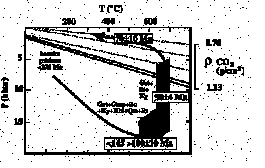
Massive scapolite quartz rocks occur as concordant bodies and discordant veins in amphibolite to eclogite facies
rocks (metaclastic rocks, amphibolitic eclogite) of the central Saualpe, Carinthia (Raith and Högelsberger, 1993). Two types of scapolite-bearing assemblages are distinguished. The first assemblage is hosted by calcareous metapelites containing scapolite, quartz, epidote group minerals, garnet, biotite, calcite and rutile, the second one is restricted to calc-silicate lithologies and is characterised by scapolite, quartz, tremolite and titanite. All scapolites, irrespective of their assemblage, are members of the marialite-meionite and marialite-mizzonite solid solution series respectively.
Scapolites in the calc-silicate assemblage are, however, characterised by slightly higher amounts of Cl (XCl=0.37-0.42) than those from metapelitic scapolites (XCl=0.16-0.28). The calculated composition of the fluids coexisting with scapolite are therefore also more saline in the calc-silicate assemblage (XNaCl fluid calc-silicates: 0.31-0.38) than in the metapelites (0.13-0.18). Fluid composition is, however, very consistent within the group of metapelitic scapolite over a large regional area. Scapolite crystallised syn- to late metamorphically with respect to (retrograde) Eoalpine amphibolite and preceding eclogite facies metamorphism.
Several types of fluid inclusions, predominantly of secondary origin, occur in quartz associated with scapolite. CO2-dominated fluids with minor contents of CH4 (max. 14 mol %) show variable densities. Maximum densities (1.13 g/cm3) were found in scapolite-quartz rocks, whereas less dense CO2 inclusions (0.7-1.13 g/cm3) are more common in scapolite-free discordant quartz veins (Fig. 1). A second type of inclusions contain aqueous highly saline H2O-salt fluids which homogenise between 170 and 210°C. The salinities of fluid inclusions containing halite daughter crystals range between 31 and 38 % NaCl equivalent.
Formation of scapolite rocks is related to metasomatic metamorphic processes. No indication for a metaevaporitic or pegmatitic origin, two genetic models proposed in previous studies, were found. Scapolite formed in the presence of moderately to strongly saline metamorphic fluids during the retrograde stages of Eoalpine metamorphism which is characterised by strong isothermal decompression.
Miller, C., Schweiz. Min. Petr. Mitt. 70, 287-300 (1990).
Raith, J. G. & Högelsberger, H., Mitt. Öster. Min. Ges. 139, 169-183 (1993).
Thöni, M. & Jagoutz, E., Geochim. Cosmochim. Acta 56, 347-368 (1992).
Fig. 1: P-T conditions and ages of eclogite and amphibolite facies metamorphism in the Saualpe (Miller, 1990; Thöni and Jagoutz, 1992). Isochores of dense CO2 inclusions (solid lines) are consistent with formation during the retrograde decompressional amphibolite facies event; less dense CO2 inclusions (dashed lines) formed during retrograde cooling.